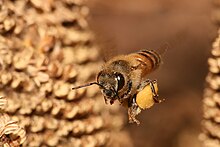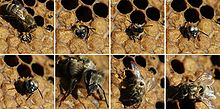
Hi Everybody!!
The birds I am referring to are Hummingbirds and the bees are Honeybees. Both are pollinators. Shared below is Wikipedia info excerpts about honeybees. Bees are not known to migrate like the birds do. Yet again this year, the bees have followed the birds to this stop over at Kates Cabin. The bees hang on the feeders and I have turkey platters of sugar water set out for them. The birds and bees engage in fierce battles for the feeders. I call it the Wild Bird Rodeo! In the coming weeks the photos I have captured will tell the story. There are over 200 hummers as of today and hundreds of bees. I have a professional Photographer coming tomorrow to help me catch this Migration Happening! Stay Tuned and Enjoy!!

Ruby-throated Hummingbird flashing his red Gorget


The bees arrived after the hummers began coming in.

Picasa/G+ Web Album link:
https://plus.google.com/u/0/photos/117645114459863049265/albums/6056332826908618609


https://en.wikipedia.org/wiki/Honey_bee
Honey bee
From Wikipedia, the free encyclopedia
Honey bees (or honeybees) are bees of the genus Apis, primarily distinguished by the production and storage of honey and the construction ofperennial, colonial nests from wax. Honey bees are the only extant members of the tribe Apini, all in the genus Apis. Currently, only seven species of honey bee are recognized, with a total of 44 subspecies,[1] though historically, from six to 11 species have been recognised. Honey bees represent only a small fraction of the roughly 20,000 known species of bees. Some other types of related bees produce and store honey, but only members of the genusApis are true honey bees. The study of honey bees is known as apiology.
| Honey bees Temporal range: Oligocene–Recent | |
|---|---|
 | |
| European honey bee carrying pollen back to the hive | |
| Scientific classification | |
| Kingdom: | Animalia |
| Phylum: | Arthropoda |
| Class: | Insecta |
| Order: | Hymenoptera |
| Family: | Apidae |
| Subfamily: | Apinae |
| Tribe: | Apini Latreille, 1802 |
| Genus: | Apis Linnaeus, 1758 |
Lifecycle[edit]
As in a few other types of eusocial bees, a colony generally contains one queen bee, a fertile female; seasonally up to a few thousand drone bees or fertile males;[9] and a large seasonally variable population of sterile femaleworker bees. Details vary among the different species of honey bees, but common features include:
1. Eggs are laid singly in a cell in a wax honeycomb, produced and shaped by the worker bees. Using herspermatheca, the queen actually can choose to fertilize the egg she is laying, usually depending on into which cell she is laying. Drones develop from unfertilised eggs and are haploid, while females (queens and worker bees) develop from fertilised eggs and are diploid. Larvae are initially fed with royal jelly produced by worker bees, later switching to honey and pollen. The exception is a larva fed solely on royal jelly, which will develop into a queen bee. The larva undergoes several moultings before spinning a cocoon within the cell, and pupating.
2. Young worker bees clean the hive and feed the larvae. When their royal jelly-producing glands begin to atrophy, they begin building comb cells. They progress to other within-colony tasks as they become older, such as receiving nectar and pollen from foragers, and guarding the hive. Later still, a worker takes her first orientation flights and finally leaves the hive and typically spends the remainder of her life as a forager.
3. Worker bees cooperate to find food and use a pattern of "dancing" (known as the bee dance or waggle dance) to communicate information regarding resources with each other; this dance varies from species to species, but all living species of Apis exhibit some form of the behavior. If the resources are very close to the hive, they may also exhibit a less specific dance commonly known as the "round dance".
4. Honey bees also perform tremble dances, which recruit receiver bees to collect nectar from returning foragers.
5. Virgin queens go on mating flights away from their home colony to a drone congregation area, and mate with multiple drones before returning. The drones die in the act of mating. Queen honey bees do not mate with drones from their home colony.
6. Colonies are established not by solitary queens, as in most bees, but by groups known as "swarms", which consist of a mated queen and a large contingent of worker bees. This group moves en masse to a nest site scouted by worker bees beforehand. Once they arrive, they immediately construct a new wax comb and begin to raise new worker brood. This type of nest founding is not seen in any other living bee genus, though several groups ofvespid wasps also found new nests by swarming (sometimes including multiple queens). Also, stingless bees will start new nests with large numbers of worker bees, but the nest is constructed before a queen is escorted to the site, and this worker force is not a true "swarm".
Pollination[edit]
Main articles: Pollination management and List of crop plants pollinated by bees
Species of Apis are generalist floral visitors, and will pollinate a large variety of plants, but by no means all plants. Of all the honey bee species, only Apis mellifera has been used extensively for commercial pollination of crops and other plants. The value of these pollination services is commonly measured in the billions of dollars. Bees collect 66 pounds of pollen per year, per hive.[11]
Bee products[edit]
Honey[edit]
Main article: Honey
Honey is the complex substance made when the nectar and sweet deposits from plants and trees are gathered, modified, and stored in the honeycomb by honey bees as a food source for the colony. All living species of Apishave had their honey gathered by indigenous peoples for consumption, though for commercial purposes, only A. mellifera and A. cerana have been utilized to any degree. Honey is sometimes also gathered by humans from the nests of various stingless bees.
In 1911, a bee culturist estimated a quart (about a litre) of honey represented bees flying over an estimated 48,000 miles to gather the nectar needed to produce the honey.[12]
Nectar[edit]
Main article: Nectar
Nectar, a liquid high in sucrose, is produced in plant glands known as nectaries. It is an important energy resource for honey bees and plays a significant role in foraging economics and evolutionary differentiation between different subspecies. It was proposed through an experiment conducted with the African honey bee, A. m. scutellata, that nectar temperature impacts the foraging decisions of honey bees.[13]
Beeswax[edit]
Main article: Beeswax
Worker bees of a certain age will secrete beeswax from a series of glands on their abdomens. They use the wax to form the walls and caps of the comb. As with honey, beeswax is gathered by humans for various purposes.
Pollen[edit]
Main article: Pollen
Bees collect pollen in the pollen basket and carry it back to the hive. In the hive, pollen is used as a protein source necessary during brood-rearing. In certain environments, excess pollen can be collected from the hives of A. mellifera and A. cerana. It is often eaten as a health supplement. It also has been used with moderate success as a source of pollen for hand pollination However, pollen collected by bees and harvested for pollination must be used within a few hours because it loses its potency rapidly, possibly because of the effects of enzymes or other chemicals from the bees; hand-collected pollen may remain usable for weeks, if stored promptly under suitable conditions.
Propolis[edit]
Main article: Propolis
Propolis or bee glue is created from resins, balsams, and tree saps. Those species of honey bees that nest in tree cavities use propolis to seal cracks in the hive. Dwarf honey bees use propolis to defend against ants by coating the branch from which their nest is suspended to create a sticky moat. Propolis is consumed by humans as a health supplement in various ways and also used in some cosmetics

...this is brendasue signing off from Rainbow Creek. See you next time!

O+O











No comments:
Post a Comment